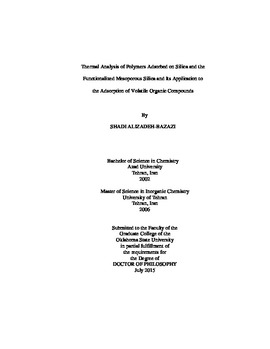| dc.contributor.advisor | Materer, Nicholas F. | |
| dc.contributor.author | Alizadeh-Bazazi, Shadi | |
| dc.date.accessioned | 2016-09-29T18:37:53Z | |
| dc.date.available | 2016-09-29T18:37:53Z | |
| dc.date.issued | 2015-07 | |
| dc.identifier.uri | https://hdl.handle.net/11244/45225 | |
| dc.description.abstract | The thermal behavior of adsorbed poly(vinyl acetate) (PVAc) on silica was determined using temperature-modulated differential scanning calorimetry (TMDSC). PVAc samples with different molecular masses (260, 170 and 100 kDa) were studied. PVAc with high and medium molecular masses, had 0.91±0.31 mg/m2 and 0.66±0.16 mg/m2 amounts of tightly-bound polymer, respectively. The low molecular mass PVAc had a smaller amount of tightly-bound polymer (about 0.53±0.02 mg/m2). The ratios of the heat capacity changes in the glass transition region were consistent with the tightly-bound PVAc in a more restricted environment than the bulk polymer. | |
| dc.description.abstract | Functionalized hexagonal mesoporous silica, in powder and pellet forms, was prepared by chemical modification of mesoporous silica with both chlorine-based and alkoxide silylating agents of different chain lengths. The 13C and 29Si NMR and TGA results show that both methods can functionalize the surface of mesoporous silica. Better loading of organic moieties was found when using hexyltrimethoxysilane. A hydrolysis study shows that chlorotrimethylsilane functionalized mesoporous silica can be readily hydrolyzed, but the surfaces generated from the alkoxide silylating agents are more stable. Toluene, nitrobenzene, and naphthalene have been used as adsorbents to probe the difference between pure and functionalized mesoporous silica. Heats of vaporization or sublimation for toluene, nitrobenzene and naphthalene have been measured using an optical absorption method for the pure material and pure and functionalized mesoporous silica. Since, mesoporous silica is a hydrophilic material; nitrobenzene binding energy to the hydroxylated mesoporous silica is higher compared with the functionalized mesoporous silica because of the polarity of nitrobenzene resulting in higher affinity to the hydroxyl groups of mesoporous silica. In contrast, the functionalized mesoporous silica samples exhibit hydrophobic properties. Toluene and naphthalene binding energies to the functionalized mesoporous silica are higher than for the hydroxylated mesoporous silica. | |
| dc.format | application/pdf | |
| dc.language | en_US | |
| dc.rights | Copyright is held by the author who has granted the Oklahoma State University Library the non-exclusive right to share this material in its institutional repository. Contact Digital Library Services at lib-dls@okstate.edu or 405-744-9161 for the permission policy on the use, reproduction or distribution of this material. | |
| dc.title | Thermal analysis of polymers adsorbed on silica and the functionalized mesoporous silica and its application to the adsorption of volatile organic compounds | |
| dc.contributor.committeeMember | Apblett, Allen | |
| dc.contributor.committeeMember | Bunce, Richard | |
| dc.contributor.committeeMember | El Rassi, Ziad | |
| dc.contributor.committeeMember | Ley, Tyler | |
| osu.filename | AlizadehBazazi_okstate_0664D_13973.pdf | |
| osu.accesstype | Open Access | |
| dc.type.genre | Dissertation | |
| dc.type.material | Text | |
| thesis.degree.discipline | Chemistry | |
| thesis.degree.grantor | Oklahoma State University | |
